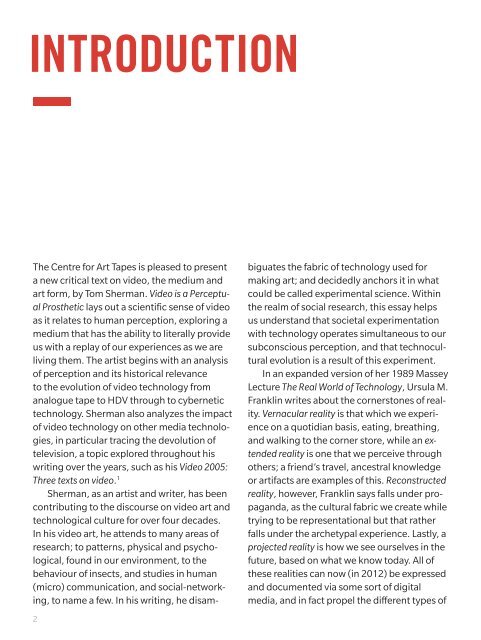video is a perceptual prosthetic - Centre for Art Tapes
video is a perceptual prosthetic - Centre for Art Tapes
video is a perceptual prosthetic - Centre for Art Tapes
You also want an ePaper? Increase the reach of your titles
YUMPU automatically turns print PDFs into web optimized ePapers that Google loves.
INTRODUCTION<br />
2<br />
The <strong>Centre</strong> <strong>for</strong> <strong>Art</strong> <strong>Tapes</strong> <strong>is</strong> pleased to present<br />
a new critical text on <strong>video</strong>, the medium and<br />
art <strong>for</strong>m, by Tom Sherman. Video <strong>is</strong> a Perceptual<br />
Prosthetic lays out a scientific sense of <strong>video</strong><br />
as it relates to human perception, exploring a<br />
medium that has the ability to literally provide<br />
us with a replay of our experiences as we are<br />
living them. The art<strong>is</strong>t begins with an analys<strong>is</strong><br />
of perception and its h<strong>is</strong>torical relevance<br />
to the evolution of <strong>video</strong> technology from<br />
analogue tape to HDV through to cybernetic<br />
technology. Sherman also analyzes the impact<br />
of <strong>video</strong> technology on other media technologies,<br />
in particular tracing the devolution of<br />
telev<strong>is</strong>ion, a topic explored throughout h<strong>is</strong><br />
writing over the years, such as h<strong>is</strong> Video 2005:<br />
Three texts on <strong>video</strong>. 1<br />
Sherman, as an art<strong>is</strong>t and writer, has been<br />
contributing to the d<strong>is</strong>course on <strong>video</strong> art and<br />
technological culture <strong>for</strong> over four decades.<br />
In h<strong>is</strong> <strong>video</strong> art, he attends to many areas of<br />
research; to patterns, physical and psychological,<br />
found in our environment, to the<br />
behaviour of insects, and studies in human<br />
(micro) communication, and social-networking,<br />
to name a few. In h<strong>is</strong> writing, he d<strong>is</strong>ambiguates<br />
the fabric of technology used <strong>for</strong><br />
making art; and decidedly anchors it in what<br />
could be called experimental science. Within<br />
the realm of social research, th<strong>is</strong> essay helps<br />
us understand that societal experimentation<br />
with technology operates simultaneous to our<br />
subconscious perception, and that technocultural<br />
evolution <strong>is</strong> a result of th<strong>is</strong> experiment.<br />
In an expanded version of her 1989 Massey<br />
Lecture The Real World of Technology, Ursula M.<br />
Franklin writes about the cornerstones of reality.<br />
Vernacular reality <strong>is</strong> that which we experience<br />
on a quotidian bas<strong>is</strong>, eating, breathing,<br />
and walking to the corner store, while an extended<br />
reality <strong>is</strong> one that we perceive through<br />
others; a friend’s travel, ancestral knowledge<br />
or artifacts are examples of th<strong>is</strong>. Reconstructed<br />
reality, however, Franklin says falls under propaganda,<br />
as the cultural fabric we create while<br />
trying to be representational but that rather<br />
falls under the archetypal experience. Lastly, a<br />
projected reality <strong>is</strong> how we see ourselves in the<br />
future, based on what we know today. All of<br />
these realities can now (in 2012) be expressed<br />
and documented via some sort of digital<br />
media, and in fact propel the different types of


